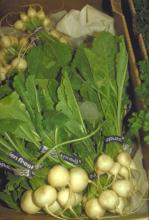Product Description
Indices de Maturité
Radish (Raphanus sativus L.) is a diversely formed root vegetable and has many uses worldwide. Red and icicle radish are most common but Asian "daikon" types are increasing in popularity outside of countries such as Korea, Japan, Taiwan and China. The number of days post-seeding or emergence, which may vary from 30 to 70 days, depending on type, typically determines maturity. A minimum size standard for common red radish is 5/8 inch (1.6 cm) equatorial diameter. Current crop management practices stress rapid growth to ensure a mild flavor and crisp texture. Fertilization and irrigation management, or environmental conditions that slow growth may result in a woody texture and high pungency. Over-mature radish tends to be pithy (vacuolated) or spongy in texture and may develop harsh flavors, for most palates.
Roots of Bunched or Topped Common Red Radish should, ideally, be of uniform and similar shape for the variety, well formed, smooth, firm but of tender texture, and free of growth or harvest damage, and free of decay, disease or insects. Bunched radish tops should be fresh in appearance, turgid, and free of freeze injury or other serious injury, seed stalk, yellowing or other discoloration, disease, decay, or insects.
U.S. Grade Standards effective October 1968 includes U.S. No. 1 and Commercial
Manipulation et stockage post-récolte
32°F (0°C)
Rapid cooling is essential to achieve the full storage potential of both bunched and topped roots. Radish is often top-iced to maintain temperature and contribute moisture for retaining a crisp texture. Under these conditions common red radish may be expected to maintain acceptable quality for 7 to 14 days with tops and 21 to 28 days if topped. Daikon-type radish may last from 3 to 4 months at these same conditions.
Common Red Radish:
| Temperature | 0°C (32°F) | 5°C (41°F) | 10°C (50°F) | 20°C (68°F) |
| ml CO2/kg·hr | ||||
| Bunched | 6-7 | 8-9 | 14-16 | 58-62 |
| Topped | 2-4 | 3-5 | 6-7 | 19-26 |
To calculate heat production multiply ml CO2/kg·hr by 440 to get Btu/ton/day or by 122 to get kcal/metric ton/day.
Not Sensitive. Bunched tops may exhibit yellowing with prolonged storage and ethylene exposure.
95-100%
Very low;
Atmospheres of 1 to 2% O2 and 2 to 3% CO2 are slightly beneficial in maintaining quality of topped radish when storage temperatures are 5 to 7°C (41 to 45°F). CA helps retard the re-growth of shoots and rootlets in "topped and tailed" roots. Even short exposure to temperatures above 7°C (45°F) will result in the development of off-flavors, browning, and soft-rot.
Désordres
Freeze injury. As radish is, ideally, stored and transported just above the freezing point (30.5°F/-1.0°C), freeze injury is not uncommon. Shoots become water-soaked, wilted, and turn black. Roots appear water-soaked and glassy, often only at the outer layers if the freezing temperature is not too low. Roots become soft quickly on warming and pigmented roots may "bleed" (lose pigment).
Bacterial Black Spot. (Xanthomonas campestris pv. vesicatoria) is a problem in some production locations and will develop in postharvest storage at warmer than optimum temperatures. Refrigeration is the primary control but washing roots in chlorinated water is reported to significantly control this disease.
Prompt cooling, chlorination, and refrigeration are also effective in controlling Bacterial Soft Rot (Erwinia carotovora subsp carotovora).
Rhizotonia spp. lesions may develop in storage at warmer than optimal temperatures but is more effectively controlled in the field. Botrytis (Grey Mold) and Sclerotinia (Watery Soft Rot) can develop, especially around harvest wounds, even at temperatures below 5°C (41°F) but is not common on radish in the U.S.
References
References from scientifically validated sources will be added in the future.



